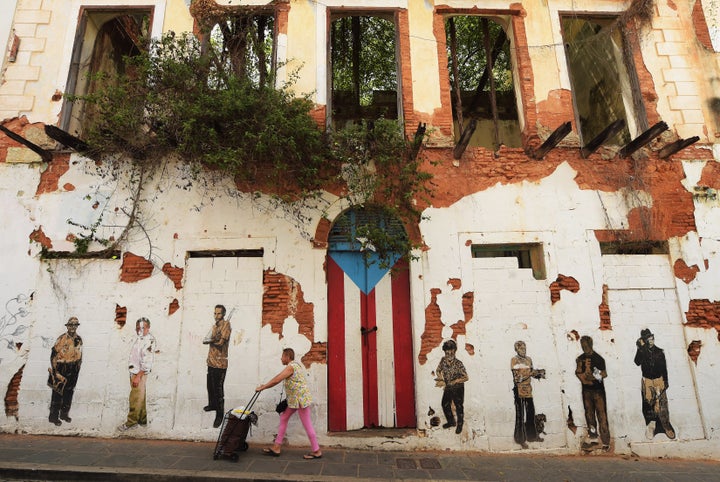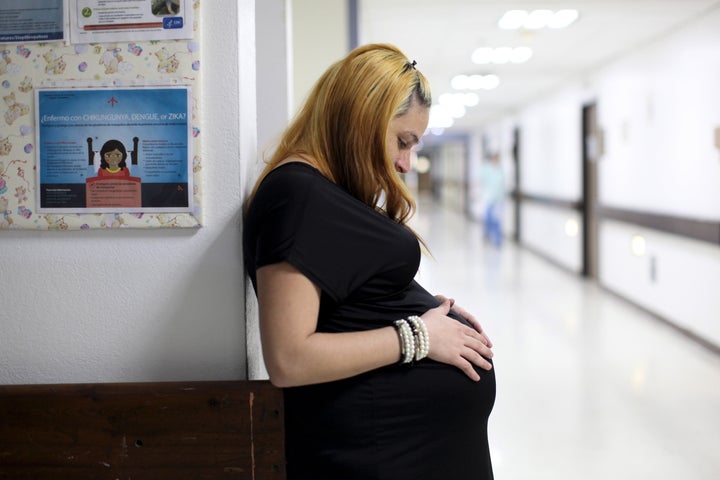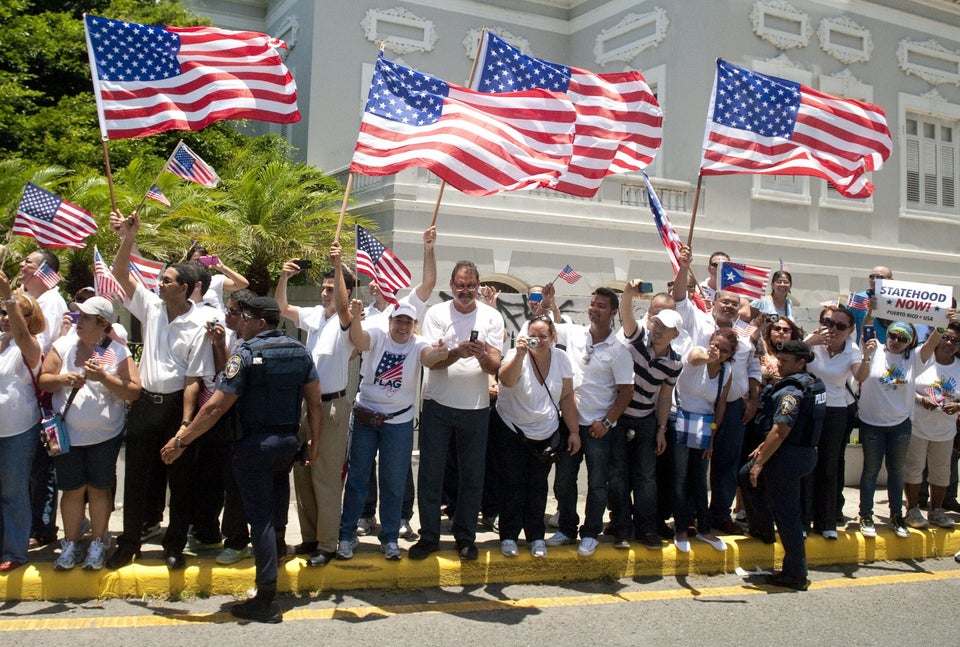
Puerto Rico's Government Development Bank defaulted on most of a $422 million debt payment that came due on Sunday, once again casting a spotlight on Congress's failure to address a spiraling debt crisis that has fueled the largest wave of emigration from the island in half a century.
"We've been forced to take emergency measures since Congress hasn't acted," Puerto Rican Gov. Alejandro García Padilla said Sunday night in a televised speech.
The amount that was due Sunday accounts for just a small portion of the $70 billion debt burden that Puerto Rico’s government owes its external lenders. But defaulting on the payment will likely subject the island to more lawsuits, even as Congress dilly-dallies on legislation that would give it some relief.
Puerto Rico faces a July 1 deadline for a much larger debt service payment of roughly $2 billion.
Here are five things you need to know about what's going on in Puerto Rico, how the situation got so bad and what the future holds.
1. Puerto Rico’s financial crisis has taken a massive human toll.
In recent years, Puerto Rico’s government has made increasingly drastic spending cuts and tax hikes in order to meet its obligations to creditors. The government laid off tens of thousands of public employees and raised the sales tax from 7 percent to 11.5 percent. It has closed some 10 percent of Puerto Rico’s schools since 2014, driving a sharp rise in the size of classes. Even more schools are due for closure in the near future.
The strains on public health infrastructure have made it more difficult for the island to combat an outbreak of the Zika virus.
The relentless austerity has also stunted the island’s economy, while cutting back the very social services that are more needed than ever. Puerto Rico had an unemployment rate of 11.8 percent in March -- more than twice the overall U.S. rate of 5 percent.
The poverty rate on the island is now 45 percent, according to the U.S. Census Bureau.
Puerto Ricans with the means to do so are leaving in droves for the mainland U.S., which their status as U.S. citizens makes a relatively simple move. The largest exodus in 50 years has resulted in a 9-percent drop in the island’s population, further eroding its tax base.

2. The island's political status helped create the debt crisis.
There are many reasons why Puerto Rico has racked up so many IOUs. It is true, as many conservatives claim, that consecutive governments deferred hard fiscal choices by continuing to issue bonds long after the island could no longer afford to take on more debt. Widespread official corruption and notoriously inefficient state-run utilities are a few of the other underlying challenges that Puerto Rico faces.
But Puerto Rico’s unusual standing as a territory over which Congress enjoys extraordinary power may also have hindered its ability to achieve economic independence -- and thus pushed it to incur so much debt to fund public services.
In 1976, Congress granted U.S. corporations a tax exemption for income earned in Puerto Rico (and other U.S. territories), prompting decades of economic growth on the island. When Congress passed another law in 1996 phasing out that exemption over 10 years, the island began an economic decline from which it has yet to recover.
Puerto Rico also suffers from the effects of the Jones Act, an early 20th-century law that bars foreign-flagged ships from traveling from one U.S. port to another. Foreign-flagged ships must instead transfer their cargo to U.S.-flagged ships after arriving at the first U.S. port. With Puerto Rico often the second port of call, the law helps make consumer goods more expensive there than on the mainland.
In addition, Medicare and Medicaid’s reimbursements to health care providers in Puerto Rico are a fraction of their mainland levels. Recent cuts as a result of the Affordable Care Act have lowered the Medicaid rate even further, reducing access to essential medical care for some of the island’s poorest residents. Sixty-eight percent of Puerto Ricans rely on one of the two programs for their health insurance, according to the Puerto Rico Health Care Crisis Coalition, an industry- and labor-backed alliance.
3. That same status deprives Puerto Rico of a key economic tool.
The island’s three main public utilities owe bondholders some $20 billion -- a significant slice of the total $70 billion debt. If Puerto Rico had the same bankruptcy powers that the 50 states enjoy, it could authorize those companies to go to court to reduce their debts. But federal law does not permit the island to extend bankruptcy protections to its municipalities and public corporations.
In March, Puerto Rico presented a different legal interpretation to the Supreme Court, making the case that it can grant bankruptcy protections to its municipalities and public corporations. The high court is expected to announce a decision in the matter by late June.
4. Hedge funds and other politically connected creditors are making the situation worse.
A portion of Puerto Rico’s debt is held by hedge funds known as “vultures,” because of their ruthless pursuit of profit from impoverished debtor governments. The vulture funds appear to be using front groups to influence congressional debate on measures that could relieve Puerto Rican debt at the creditors' expense. 60 Plus, a conservative seniors' group that is funded by a few wealthy anonymous donors and played a lead role in opposing the Affordable Care Act, set up a group called "Main Street Bondholders" to fight efforts in Congress to provide Puerto Rico with even the most modest bankruptcy powers.
While Main Street Bondholders claims to represent ordinary citizens invested in Puerto Rican debt, The New York Times reported that DCI, a public relations firm that specializes in faux grassroots campaigns, enlisted 60 Plus in the effort. BlueMountain Capital Management, a vulture hedge fund with major holdings of Puerto Rico Electric Power Authority debt, is a client of DCI. BlueMountain, the Times noted, has also been one of the hedge funds most aggressively lobbying Congress against intervention on behalf of Puerto Rico in above-ground ways.
Another organization, the Center for Individual Freedom, has been running television ads against the same legislative proposals. Although its donors are anonymous, CFIF is widely suspected of being a front for hedge funds that own Puerto Rican debt.

5. Congress is dragging its feet.
For a time it looked like congressional aid was finally on the way. After months of dithering as the crisis escalated, the House subcommittee with jurisdiction over Puerto Rico unveiled a draft bill at the end of March that would give the island some very limited access to court-supervised debt restructuring in exchange for a Washington-based fiscal oversight board.
House Speaker Paul Ryan (R-Wis.) said passing an aid package was a priority. House Democrats, while critical of some aspects of the bill, said Republicans were negotiating in good faith and professed their commitment to finding an acceptable compromise. (Even then, not everybody was on board with the "let's be positive" approach: Democratic presidential hopeful Sen. Bernie Sanders (I-Vt.) immediately called for the bill to be defeated outright.)
In mid-April, however, talks between the two parties reached an impasse with Democrats and Republicans involved in the process refusing to meet. Democrats wanted to weaken the fiscal oversight board, while Republicans in the ultra-conservative House Freedom Caucus expressed what appear to be more fundamental objections to the debt restructuring provisions.
That makes the prospects of congressional action before May 1 virtually nonexistent. On Tuesday, House Majority Leader Kevin McCarthy (R-Calif.) ramped up the pessimism when he voiced doubt that Congress would do anything before Puerto Rico’s next major debt repayment deadline on July 1.
Puerto Rico owes its creditors $2 billion on that date, including more than $800 million in "must pay" general obligation bonds.
This story has been updated to reflect Puerto Rico's default on most of the debt payment due May 1.
CORRECTION: A previous version of this article said BlueMountain Capital management had set up Main Street Bondholders. BlueMountain is a client of the PR firm that reportedly is behind Main Street Bondholders' efforts. The article also stated that BlueMountain holds general obligation debt; it holds municipal utility debt.

